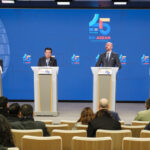As Chinese people opt to avoid going out in face of COVID infection surge this week amid government’s efforts to flatten the infection curve, consumption is seen as being a major casualty, but Chinese economists said the impact will be rather temporary, with even no major dent on the December consumption data expected.
Despite a noticeable decrease in the number of people on the streets or in the malls, after China has optimized its epidemic response measures, a number of Chinese enterprises have expressed their positivity on the economic outlook and are seeing the Spring Festival holiday (January 21-27) as what could be the first opportunity for pent-up demand to explode, the Global Times learnt.
Holding out
Since the government announced optimized anti-COVID epidemic response measures on December 7, cities across China have seen a marked decrease in people leaving their homes as people choose to stay put to avoid being infected.
Many restaurants in Beijing have suspended dine-in services, offering only food delivery or takeaway services. Shopping malls, though open, are frequented with very few people.
In Central China’s Hunan Province, Liu Renjun, a manager of Hunan Xiangjun Catering Co, told the Global Times on Thursday that the attendance to his restaurants fell by more than half this week compared with two weeks ago but he still keeps his eight restaurants open.
“Many people around me have been tested positive for COVID and diners choose not to dine outside,” Liu said. “But I am counting on people’s cautious reaction to end before the Spring Festival, which is a vital season of income for catering industries.”
“I think the Chinese society will come back in full strength at latest by next March and April, and I am already planning to open up a new restaurant by then to tap the recovered consumption,” Liu said, noting three years’ fight with epidemic has taught him to optimize his operation to keep its impact to the minimum.
Yang Ying, vice general manager of Windsor KTV, a leading KTV company in China, told the Global Times on Thursday that her company is still keeping operation despite a low attendance and the loss incurred by the down time.
“We are feeling the stone to cross the river. We are taking a wait-and-see stance,” Yang said.
On Thursday, China’s posted November retail sales data, which was down 5.9 percent year-on-year. Industrial production also slowed to only a 2.2 percent increase.
Impact to be ‘temporary’
Despite the weak November data and people avoiding going out have fueled worries that eased COVID restrictions may not bring about economic recovery as much as possible, however, economists interviewed by the Global Times said they are cautiously optimistic about growth in December, saying the impact is partial, phased and temporary.
Cao Heping, an economist at Peking University, told the Global Times on Thursday that the impact of the current situation will be light in what he describes as two-week-long market memory.
“People’s feelings and attitude toward a situation can fluctuate wildly in a matter of two weeks, and the new feeling often negate the older feelings,” Cao said. “As people get out of one system and venture into another, they are cautious. But once they get used to the new norms, they will be bold again.”
“If the situation just lasts for two weeks, the impact on consumption will be really light on the quarterly economic performance,” Cao said.
Experts noted that there is no need to exaggerate or amplify the impacts of external shocks had on people’s lives, production, trading and consumption.
Cao predicted that the December consumption figure will fall within moderate range, despite the current situation.
Cao said one of his friends tested positive for COVID a few days ago, but the 75-year-old chairman of a business is well and back to his role running his company just after 4 days.
Lian Ping, president of the China Chief Economist Forum, told the Global Times on Thursday that that the phenomenon of few people on the streets, restaurants and malls will be temporary.
“Not going out unless necessary is more of a result of the people’s drastically beefed-up self-protection awareness. People took a ‘wait-and-see’ attitude,” Lian said. “After a while, people will get used to the new situation.”
Lian said consumption activities that require gathering of the crowd will undoubtedly take a hit for the moment but the demand for consumption can be only deterred, not vanquished.
Lian predicted that due to the fact that December hosts a number of holidays and that the epidemic outbreak will take some time to reach other parts of the country, the consumption data in December will likely beat November’s.
Analysts said as the Chinese central government and the local governments roll out more supportive policies, the Chinese economy will speed up recovery in the coming months and years.
Supportive policies
China on Wednesday revealed a guideline aimed at further expanding domestic demand with the goal to raise the scale of consumption and investment to a new level by 2035, as the country accelerates the building of a “dual circulation” development paradigm to ensure long-term high-quality growth.
On the same day, Ministry of industry and Information Technology vowed to guarantee the supply of key drugs and ramp up productions of antigen test kits, vaccines and personal protection equipment.
State Post Bureau said on Wednesday that most of the chokepoints across the country have been effectively smoothened, and the delivery business is recovering rapidly with 360 million packages mailed every day since the optimization measures were announced. Currently, express delivery companies are channeling deliverymen from other parts of the country to Beijing to ease the city’s current situation.
China’s growth rate will still top the world’s leading economies, perhaps only trailing behind India, according to economists.
Even as the IMF has downgraded China’s growth forecast for 2022 to 3.2 precent, citing downward pressure, the growth rate of China still leads the 1.6-percent-growth of the US and the 3.1-percent-growth of the EU.
Summing up her meeting with Chinese Premier Li Keqiang, IMF Managing Director Kristalina Georgieva said in a December 9 statement that recalibrating COVID policies can create a better impetus for reviving growth in China, which can be very good for the Chinese people and economy, and also good for Asia and the world economy.
International data analytics company Nielsen said on Wednesday that China’s consumption goods market has already showed signs of a recovery, albeit at slower growth rate. And over half of the surveyed entrepreneurs say the 2022 economic performance is better than they anticipated and maintained a rather positive outlook on the Chinese economy and their trade toward 2023.
Xu Xiaolei, marketing manager at China’s CYTS Tours Holding Co, told the Global Times on Thursday that his company is making full preparations for the New Year holiday and the Spring Festival holidays in terms of designing tour packages and recuperate their human resources as well as sorting out issues with services suppliers and partners.
“Although I believe people’s desire to travel still need further boost by stabilizing messages, I still see such desire on a slowly growing trajectory,” Xu said.
For many Chinese like Liu, Yang and Xu, hunkering down is only a preceding step for spring forward in a more adroit manner for the Spring that lies ahead.
“Now no one asks us to suspend operation due to epidemic control measures any more, and improving road traffic improved our supply chain, we just wait for our customers to return,” Liu said.
Liao Qun, chief economist with Chongyang Institute for Financial Studies at Renmin University of China, told the Global Times he expects people to shift from cautiousness to boldness after the Spring Festival and full-scale revenge-style consumption to return in 2023.
Such a rebound, as a result of both government supportive policies and people’s consumption habit, will likely be stronger than the one we experienced in 2020 and 2021, Liao said.
In 2021, China’s GDP jumped to 8.1 percent annual growth, compensating for the 2.2 percent recorded for 2020.
(Global Times)




